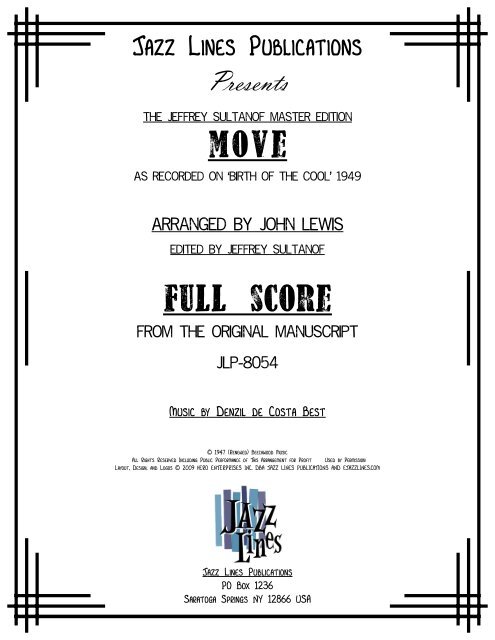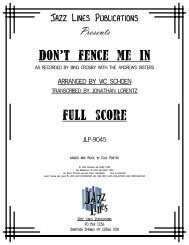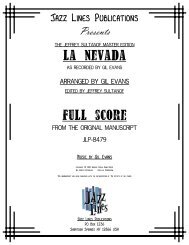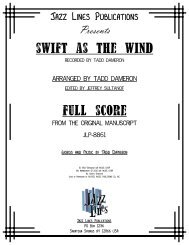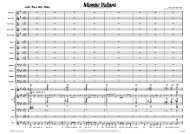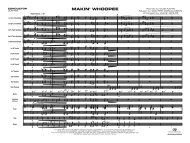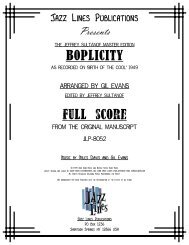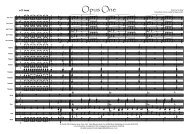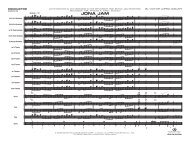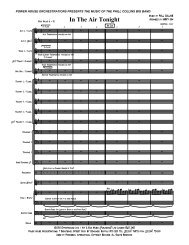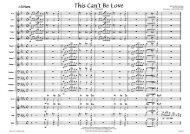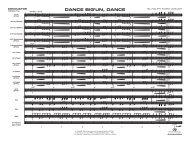Move - JLP-8054 - Score.mus - Ejazzlines.com
Move - JLP-8054 - Score.mus - Ejazzlines.com
Move - JLP-8054 - Score.mus - Ejazzlines.com
Create successful ePaper yourself
Turn your PDF publications into a flip-book with our unique Google optimized e-Paper software.
Jazz Lines PublicationsPresentsthe jeffrey sultanof master editionmoveAs recorded on ‘birth of the cool’ 1949Arranged by john lewisedited by jeffrey sultanoffull scorefrom the original manuscriptjlp-<strong>8054</strong>Music by Denzil de Costa Best© 1947 (Renewed) Beechwood MusicAll Rights Reserved Including Public Performance of This Arrangement for Profit Used by PermissionLayout, Design, and Logos © 2009 HERO ENTERPRISES INC. DBA JAZZ LINES PUBLICATIONS AND EJAZZLINES.COMJazz Lines PublicationsPO Box 1236Saratoga Springs NY 12866 USA
irth of the cool seriesmove (1948)Background:Gil Evans’ apartment on 55th street became a hangout for many <strong>mus</strong>icians who came to visit, listen to <strong>mus</strong>ic thatGil borrowed from the library (Prokofiev, Bartok, and Ernest Bloch were some of the <strong>com</strong>posers Evans wasstudying at the time), sleep, and hang out with other <strong>mus</strong>icians. Some even came to live with him for indefiniteperiods. The door was always open, even if Evans was not there. Gil said that if someone took something likemoney without telling him, that person probably needed it more than he did. Among the guests who came to theapartment were Charlie Parker, Dave Lambert, Blossom Dearie, John Carisi, George Russell, John Lewis, JohnnyMandel and Gerry Mulligan.It was at Evans’s apartment that Carisi, Russell, Mulligan, Mandel and Lewis discussed the formation of a small bandthat would duplicate the sound and homogeneity of the Claude Thornhill big band. Evans had been its chiefarranger and <strong>mus</strong>ical director before and after World War II, but he and the pianist had parted amicably by 1948because Thornhill no longer wanted to continue the ‘modern jazz’ direction Evans favored. One of the <strong>mus</strong>icianswhom everyone envisioned in the trumpet chair was Miles Davis. Not only was Davis interested, he took theensemble over, calling rehearsals and getting the band a gig at the Royal Roost. By that time Mandel had gone toCalifornia to establish residency there, but everyone else contributed <strong>mus</strong>ic. Mulligan wrote the most materialthat was recorded, but for many years his considerable contribution to this ensemble was not properlyacknowledged.The ensemble ceased to exist by 1950, leaving behind twelve sides for Capitol Records and two radio broadcasts.Some of the sides were not released at the time, and the response to the ensemble was generally not veryenthusiastic. When eleven of the Capitol sides were released on LP in 1956, the reaction was overwhelminglypositive, particularly in Europe. In 1971, all twelve recordings appeared on LP in Europe, and released in the U.S.in 1972. These recordings are considered as important as the Armstrong Hot Five and Seven, the series by theEllington band from 1940-42, and Davis’s Kind of Blue.Except for a rare few, historians now consider The Miles Davis Nonet one of the most important ensembles in thehistory of jazz. Certainly such <strong>com</strong>posers as Shorty Rogers, Andre Previn, Marty Paich, John Graas, Jack Montrose,Manny Albam and Andre Hodeir were heavily influenced by the nonet, as their <strong>mus</strong>ic shows. Happily, many of theoriginal parts of the sides recorded, plus parts for other <strong>com</strong>positions and arrangements for this ensemble, werediscovered in three cartons of <strong>mus</strong>ic that Miles Davis put into storage in Philadelphia and reclaimed after hisdeath. In 2002, my edition of 12 scores from the repertoire of this ensemble was published by the Hal LeonardCorporation. An article detailing the editing process and errata in the folio itself will be published by the Journalof Jazz Studies in 2010.
The Music:<strong>Move</strong> was written by drummer Denzil Best and was arranged by pianist/<strong>com</strong>poser John Lewis. Best is mostlyremembered as the drummer for George Shearing’s quintet from 1949-1952. This track was recorded at the firstrecording session of the Miles Davis Nonet, January 21. 1949. It was in the Nonet book as early as September of1948, as the band played it at the Royal Roost when it appeared there for two weeks. Interestingly, John Lewis wasnot present at the Capitol recording session, as he had a record date with Ella Fitzgerald on the same day.Notes to the Conductor:The two main issues with the Nonet book in general are:1) Instrumental balance, so that the French horn and tuba are not buried. These two instruments tendto ‘speak’ slower than the other horns, which can drag the tempo.2) It can take many hours of practice for this <strong>mus</strong>ic to sound properly; it took many hours for the originalplayers to interpret this <strong>mus</strong>ic so that the arrangers were satisfied. Careful rehearsals and patience are thekeys to success here. As can be heard on the Royal Roost airchecks, this is a perfect piece to open up formore solos.Jeffrey Sultanof- December 2009
Jazz lines PubLications<strong>Score</strong>Alto Sax.[1]medium Swing = 132The jeffrey sultanof master editionmoveAs recorded by Miles Davison Birth of the Cool, 1949 f Music By Denzil de Costa BestArranged by John LewisEdited by Jeffrey Sultanof jLp-<strong>8054</strong>Baritone Sax. TrumpetäfHorn in FmfäfTrombone mfäfTuba (orBass Trombone) mfämfff Piano Bass Piano Tacet Until Bar 32 Drumsãmfy y y y y yœ ’ ’ ’ ’’ ’ ’ ’mf2© 1947 (Renewed) Beechwood Music Corp.All Rights Reserved International Copyright Secured Used by permissionLayout, Design, and Logos © 2009 HERO ENTERPRISES INC. DBA JAZZ LINES PUBLICATIONS AND EJAZZLINES.COMAll Rights Reserved Including Public Performance for Profit3
jLp-<strong>8054</strong>move<strong>Score</strong> - Page 2Jazz lines PubLicationsA. Sx. B. Sx. Tpt.Hn.Tbn. Tuba Bass D. S.ã(4)’ ’ ’ ’’ ’ ’ ’{F`i`l`l`}’ ’ ’ ’(7)’ ’ ’ ’4567
Jazz lines PubLicationsA. Sx.B. Sx.Tpt.Hn.Tbn.TubaBass[A](Unis. w/ Tpt) (Unis, w/ Alto) move<strong>Score</strong> - Page 3 jLp-<strong>8054</strong>D. S.ã{P`la`y` `T`im`e``}5 5 5 5œ œ ’ ’ ’ ’’ ’ ’ ’(4)’ ’ ’ ’891011


